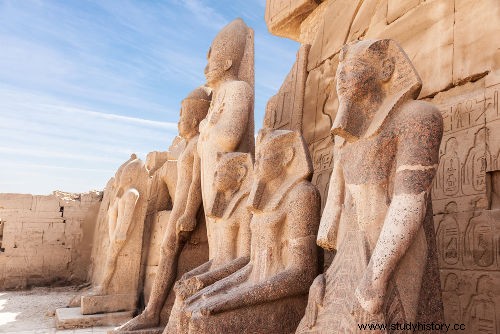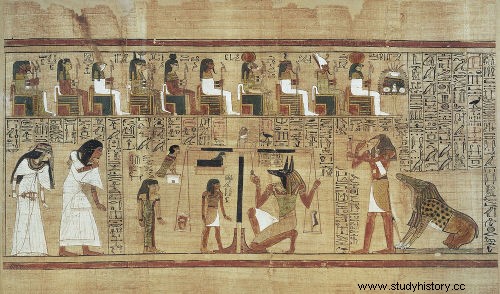The image below is a photograph of the carvings that are at the entrance to the Temples of Karnak in Luxor, Egypt.

Sculptures from Kanark Temple
It is correct to say that the Temples of Karnak were erected in context:
a) from the Middle Kingdom (2000-1580 BC), and all were dedicated exclusively to the god Anubis.
b) from before the time of the pharaohs, around 5000 BC, by Sumerian influence.
c) from the Hellenistic period, and were dedicated to the Greek Pantheon, which arrived in Egypt through Alexander the Great.
d) of the New Kingdom (1580-1085 BC), the most important of which was dedicated to the god Amun-Ra.
e) from the Old Kingdom (3200-2300 BC), and all were dedicated exclusively to the god Horus.
question 2(UFMS) About Egyptian art, it is incorrect to state:
a) The great manifestations of Egyptian architecture were the magnificent religious temples, the pyramids, the hypogea and the mastabas.
b) In the painting, the figures were represented with the eyes and shoulders in profile, although with the rest of the body in front.
c) Egyptian sculpture followed a predominantly religious orientation. There were numerous statues carved for the purpose of being inside tombs. Egyptian sculpture reached its maximum development with sarcophagi, carved in stone or wood.
d) Egyptian culture was deeply marked by the religion and political supremacy of the pharaoh. These two elements exerted great influence on the arts (architecture, sculpture, painting, literature) and on scientific activity.
e) Gradation, blending tones and chiaroscuro were not used.
question 3Read the excerpt below:
“[...] In any case, they would preserve your sacred body from decay. For the Egyptians believed that the body had to be preserved so that the soul could continue to live in the hereafter. That's why they prevented the disintegration of the corpse, thanks to an elaborate method of embalming and bandaging in strips of cloth.” (GOMBRICH, E.H. The History of Art . 16th edition. trans. Alvaro Cabral. Rio de Janeiro:LTC, 1999. p. 55.)
The text above concerns a complex of monuments quite imposing and important to the Egyptian civilization. It is:
a) from the Library of Alexandria
b) from the Taj Mahal
c) of the great pyramids of the Valley of Giza.
d) the temple of Queen Vashti
e) the Mausoleum of Helicarnassus.
question 4(UFSCAR/SP) Analyze the image:

Egyptian painting
It is correct to say that the image represents:
a) a scene from the daily life of the Hittites, weighing goods traded with the Egyptian people.
b) events of Moses' dream of liberating the Hebrew people, when he was a prisoner of the Egyptian Pharaoh.
c) the beginning of the world for the ancient Egyptians, when Nut, goddess of the sky and stars, announces her victory before Chu, god of Air.
d) the Egyptian book of the dead, with Osiris on the right and Anubis in the center, weighing a dead man's heart to assess his life.
answers Question 1Letter D
The temples of Karnak constitute one of the most prestigious artistic monuments of Egyptian art. The entire complex, from the architectural structure of the temples to the sculptures, is well preserved. The cults performed in the main of these temples were dedicated to the god Amun-Ra. This temple of Amun-Ra is over 100 meters long and has more than 130 columns with hieroglyphic inscriptions.
Question 2Letter B
The main characteristic of Egyptian painting is the frontality of the body and eyes and the laterality of the upper (arms) and lower (legs) limbs. This technique was used as a way of valuing the human body (feet, for example, were better represented from the side than from the front) and also as a way of conveying the idea of movement, of action, to anyone who saw the painting.
Question 3Letter C
The Gombrich section concerns the pyramid complex in the Valley of Giza, Egypt, located near the city of Cairo. The highlight is given to the three largest pyramids:Chephren, Qéops and Menkaure. It is interesting to note that, in addition to mausoleums, the three great pyramids also testify to the great astronomical observation capacity of the ancient Egyptians, as, when viewed from above, they are in perfect alignment with the “belt of Orion”, that is, with the three main stars in the constellation of Orion.
Question 4Letter D
The book of the dead is one of the main documents of the civilization of Ancient Egypt. The four most important deities that are part of the rites present in this book are Isis, Horus, Osiris and Anubis. The translation of the Book of the Dead was first published in German in the year 1842, the work of which was undertaken by Karl Richard Lepsius.
